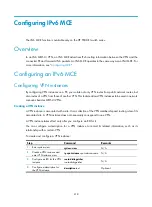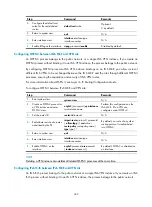
419
Associating a VPN instance with an interface
After configuring a VPN instance, you must associate the VPN instance with the interfaces connected to
the VPN site or the PE.
To associate a VPN instance with an interface:
Step Command
Remarks
1.
Enter system view.
system-view
N/A
2.
Enter interface view.
interface
interface-type
interface-number
N/A
3.
Associate a VPN instance
with the interface.
ip binding vpn-instance
vpn-instance-name
No VPN instance is associated
with an interface by default.
NOTE:
The
ip binding vpn-instance
command clears the IPv6 address of the interface on which it is configured.
Be sure to re-configure an IPv6 address for the interface after configuring the command.
Configuring route related attributes for a VPN instance
The control process of VPN route advertisement is as follows:
•
When a VPN route learned from a CE gets redistributed into BGP, BGP associates it with a route
target extended community attribute list, which is usually the export target attribute of the VPN
instance associated with the CE.
•
The VPN instance determines which routes it can accept and redistribute according to the
import-extcommunity
in the route target.
•
The VPN instance determines how to change the route targets attributes for routes to be advertised
according to the
export-extcommunity
in the route target.
IMPORTANT:
Create a routing policy before associating it with a VPN instance. Otherwise, the switch cannot filter the
routes to be received and advertised.
To configure route related attributes for a VPN instance:
Step Command
Remarks
1.
Enter system view.
system-view
N/A
2.
Enter VPN instance view.
ip vpn-instance
vpn-instance-name
N/A
3.
Enter IPv6 VPN view.
ipv6-family
Optional.
4.
Configure route targets.
vpn-target
vpn-target
&<1-8>
[
both
|
export-extcommunity
|
import-extcommunity
]
A single
vpn-target
command can
configure up to eight VPN targets.
You can configure up to 64 VPN
targets for a VPN instance.






























